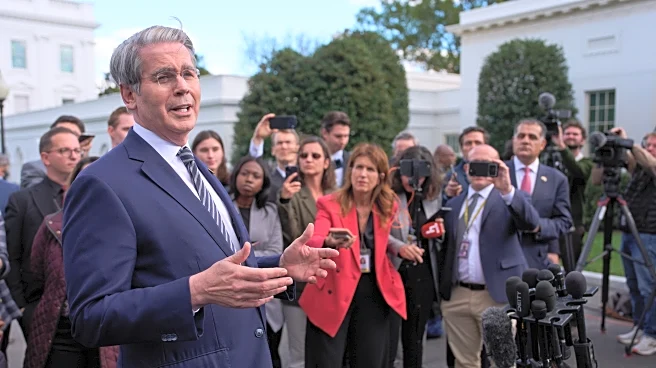What's Happening?
The U.S. national debt has reached a historic milestone, surpassing $38 trillion for the first time. According to the Treasury Department, the debt stood at $38,019,813,354,700.26 as of October 21, 2025.
This development comes just over two months after the debt hit $37 trillion in mid-August and less than a year after it crossed the $36 trillion mark last December. The rapid increase in debt is attributed to several factors, including rising enrollment in Social Security and Medicare due to an aging population, as well as increased interest expenses from servicing the federal debt. Higher interest rates, implemented to curb inflation, have also contributed to the growing debt burden. The federal government recorded a budget deficit of approximately $1.8 trillion for the fiscal year ending September 30, 2025. Projections indicate that spending on entitlement programs and debt interest will continue to drive deficits higher in the coming years.
Why It's Important?
The surpassing of the $38 trillion debt mark underscores significant concerns about the U.S. economic stability and fiscal health. The rapid accumulation of debt poses challenges for future economic growth, as high interest costs could crowd out essential public and private investments. The Congressional Budget Office (CBO) projects that the national debt held by the public will rise from about 100% of GDP in 2025 to 120% by 2035. This trajectory suggests increasing financial pressure on the government, potentially leading to higher taxes or reduced public services. The situation highlights the urgent need for fiscal reforms to address the growing debt and ensure sustainable economic policies. Stakeholders, including policymakers and economic analysts, are closely monitoring these developments, as they could have far-reaching implications for the U.S. economy and its global standing.
What's Next?
Looking ahead, the U.S. government faces the challenge of managing its fiscal policies to mitigate the impact of rising debt. The CBO forecasts that annual budget deficits could reach $2.6 trillion by 2035, adding $22.7 trillion to the national debt over the next decade. This scenario necessitates strategic decisions on spending cuts, tax reforms, and economic policies to stabilize the debt trajectory. Political leaders and economic experts are likely to engage in debates over the best approaches to address these fiscal challenges. The outcome of these discussions will be crucial in shaping the country's economic future and maintaining investor confidence in U.S. financial markets.
Beyond the Headlines
The growing national debt raises ethical and intergenerational concerns, as future generations may bear the burden of today's fiscal decisions. The increasing debt levels could limit the government's ability to respond to future economic crises or invest in critical areas such as infrastructure, education, and healthcare. Additionally, the reliance on borrowing to finance government operations may lead to increased foreign debt holdings, potentially affecting national security and economic sovereignty. These broader implications highlight the need for a comprehensive and balanced approach to fiscal policy that considers both immediate economic needs and long-term sustainability.













